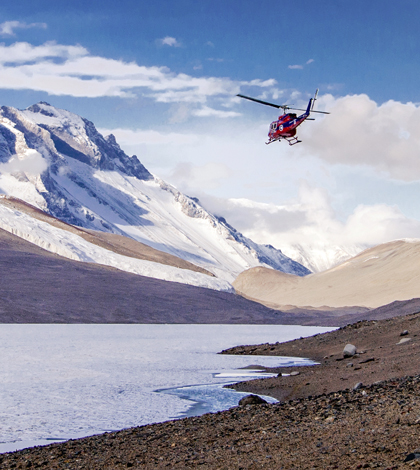Antarctic Lakes Hold On To Dissolved Black Carbon

A U.S. Antarctic Program helicopter flies through the McMurdo Dry Valleys in 2012. (Credit: Elizabeth Mockbee / National Science Foundation)
It’s long been said that lakes are sentinels for change. Researchers with the McMurdo Dry Valleys Long-Term Ecological Research Project have found more evidence of that in the sediments of several Antarctic lakes.
In addition to being almost completely scoured of ice and snow by high winds, the Dry Valleys are home to ice-covered lakes, which experience seasonal, temperature-related advances and retreats in ice cover. This takes place during the Southern Hemisphere’s summer months.
The lakes also have some unusual characteristics that make them scientifically interesting repositories for materials like dissolved black carbon (DBC), which is carried into the lakes by local streams or atmospheric circulation. Though lakes in the Dry Valleys are like other lakes that store materials flowing into them, researchers say that they have special shapes that affect their dissolved black carbon levels. The lakes are closed basins, meaning whatever goes into them effectively stays there.
To consider the levels of DBC held in the lakes, both saline and freshwater, investigators gathered sediment core samples and compared them to others gathered 25 years ago. They found that the sediments showed chemical signatures of ancient wildfires as well as more recent evidence that combustion of fossil fuels has left DBC behind. Full results of their findings are published in the journal Geophysical Research Letters.
Analysis of the lake sediments shows that brines in the lake bottoms retain DBC whose woody signature indicates the source is likely to have been burning — such as wildfires and other natural events — at lower latitudes as many as 2,500 years ago or more. Black carbon from those fires, commonly called soot, would have been transported by atmospheric winds and deposited in Antarctic glaciers. It would have later entered the lakes as part of freshwater runoff from nearby glaciers.
Over the past 25 years, the cores also show that dissolved black carbon levels from fossil fuels have gone up during the period. Compared to the levels added by wildfires more than 1,000 years ago, however, the fossil fuel contribution is small.
Investigators say there are two possible sources for the more modern DBC contributions. The first is that helicopters frequently fly in and out of the Dry Valleys to transport researchers and scientific cargo into the field. Most of that flying occurs at the peak of the Antarctic summer when the lake surfaces in the valleys experience a seasonal melt. The researchers hypothesize that emissions from the flights could settle and become dissolved black carbon. There is also a reasonable chance that carbon emissions produced elsewhere could have been transported and deposited into the lakes.
Either way, the measurements can serve as baselines for tracking environmental quality in the Dry Valleys. The fossil-fuel signature scientists uncovered may also help as an indicator of the influences that humans have already had on the Antarctic as well as what our impacts could be in the future.
Top image: A U.S. Antarctic Program helicopter flies through the McMurdo Dry Valleys in 2012. (Credit: Elizabeth Mockbee / National Science Foundation)




0 comments